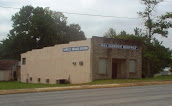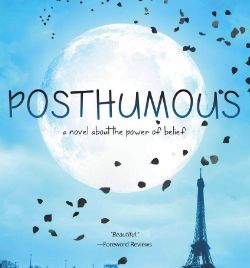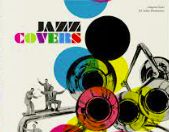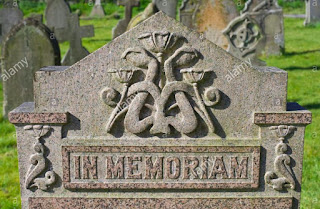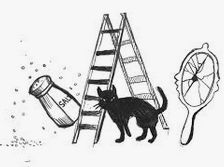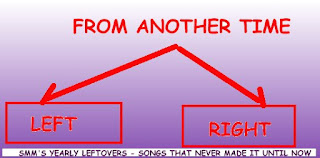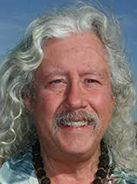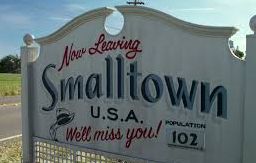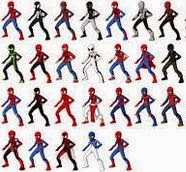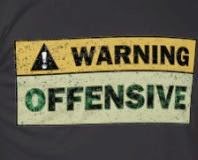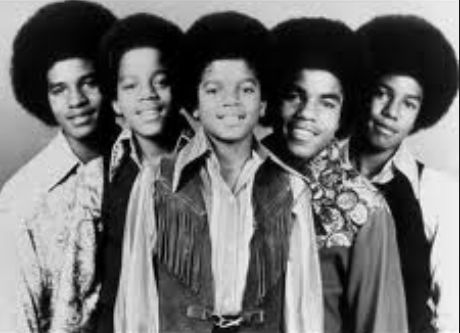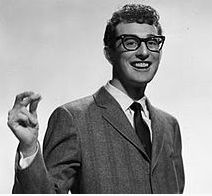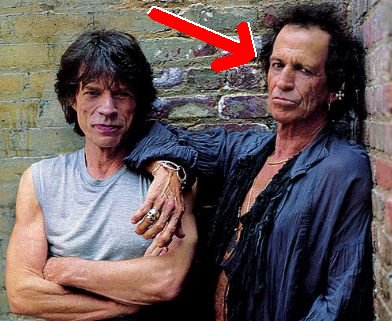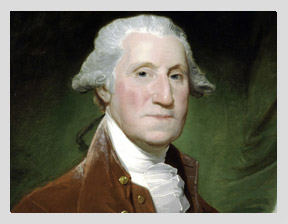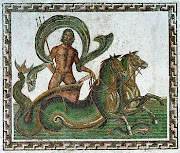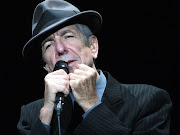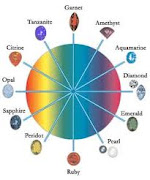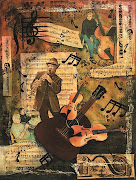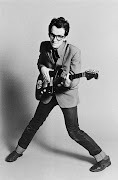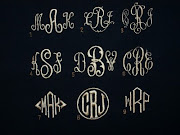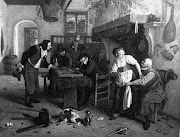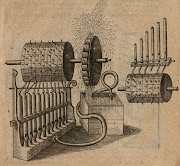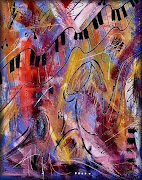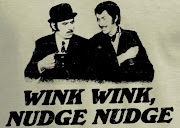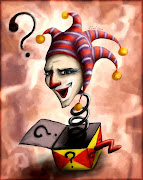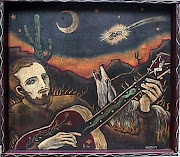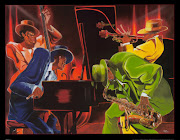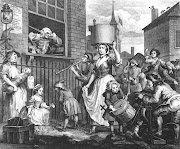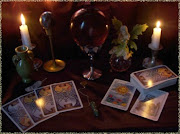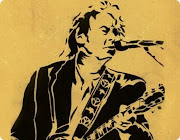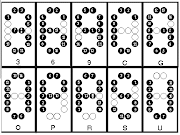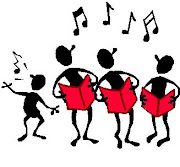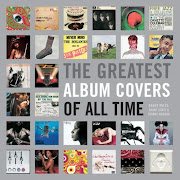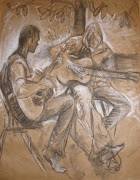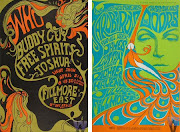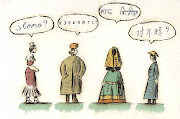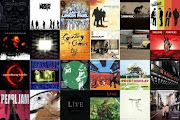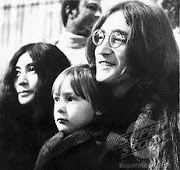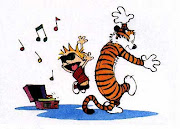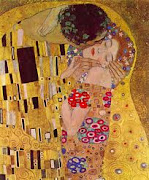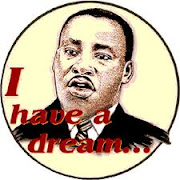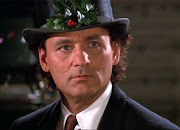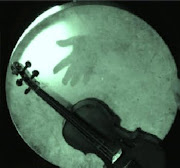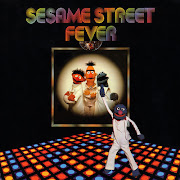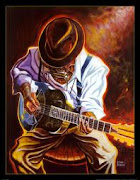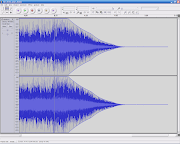The Minutemen (1980-85) were the greatest punk rock band of all-time. Better than The Clash, better than X, better than The Ramones, Hüsker Dü, Fugazi, Minor Threat, Black Flag, Bad Brains, or anyone else you'd care to name. Furthermore, their 1984 LP, Double Nickels On The Dime, is not only the greatest punk rock album ever recorded, I'd put it up against anything by Dylan, Hendrix, The Stones, The Beatles, you name it. I'm not saying it's necessarily better, but it's in the discussion.
I starting writing up a mini-bio of the band, but David Rees' heartfelt (and spot-on) essay, What Would D. Boon Do?, is better than anything I could possibly come up with. The essay is included in the Minutemen DVD, We Jam Econo [purchase], which as far as I'm concerned should be required viewing for anyone interested in rock, let alone punk rock. I'll surely delve into the Minutemen discography in future posts, so for now, please enjoy a pair of history lessons from the mighty Double Nickels.
Minutemen: Viet Nam [purchase]
let's say i got a number
that number's 50,000
that's 10%
of 500,000
oh here we are
in french indochina
executive order
congressional decision
the working masses
are manipulated
was this our policy?
ten long years
not one domino shall fall
Minutemen: History Lesson - Part 2 [purchase]
our band could be your life
real names'd be proof
me and mike watt played for years
punk rock changed our lives
we learned punk rock in hollywood
drove up from pedro
we were fucking corndogs
we'd go drink and pogo
mr. narrator, this is bob dylan to me
my story could be his songs
i'm his soldier child
our band is scientist rock
but i was e. bloom, richard hell, joe strummer, and john doe
me and mike watt, playing guitar
D. Boon is dead. Long live D. Boon.
Saturday, May 17, 2008
History Lesson - Part 2: Minutemen Edition
Posted by LD at 5:37 PM 8 comments
Labels: D. Boon, George Hurley, History, Mike Watt, Minutemen
History: Scott Miller Edition
"I am behind the times. But not so far that I don't realize the futility of making a 'regional' record in a 'global' world. By looking at my past, not just of my life but of my family, I can gather clues to what makes me as I am."
--Scott Miller
If you don't know Scott Miller, a brief history lesson is in order. In the mid-to-late 1990s, he co-fronted The V-Roys, a blast furnace of kickass rock 'n' roll, like a slightly twangier Soul Asylum circa ... And The Horse They Rode In On or The Replacements circa Pleased To Meet Me.
Following the V-Roys' 1999 breakup ... a moment of silence, please ... Miller ventured into solo territory, with a succession of albums progressively more informed by historical memory. His first studio album, in fact, was titled, Thus Always To Tyrants, which not only serves as the Virginia state motto, but in its Latin form (Sic semper tyrannis), was the phrase John Wilkes Booth snarled in Ford's Theatre after shooting President Lincoln.
Miller's songs often venture into personal history, which we'll get to in a moment, but his subject matter also includes such weighty subjects as The Civil War and World War II, which we'll also get to in a moment. This love for the past manifested itself most poetically in his January 2004 Amtrak Crescent Tour, in which he hit 15 cities by train, beginning with New Orleans and ending with New York City ... or as he likes to call it, New New Amsterdam. He's such a stickler, that Miller.
So, that's the background, here's the tunes.
V-Roys: Virginia Way/Shenandoah Breakdown [purchase]
Coming at the tail end of the V-Roys run, this is a personal homage to Scott's family and his home state of Virginia. We didn't realize it then, but this was a sign of things to come. And for the "Shenandoah Breakdown," he enlisted the help of genuine bluegrass royalty in The Del McCoury Band.
Scott Miller: Daddy Raised A Boy [purchase]
An incisive personal history, but with a great reference to the bombing of Japan. If we ever tackle the father theme, someone else can do "Cat's In The Cradle," I'm taking this one.
Scott Miller: Highland County Boy [purchase]
A Civil War tale rendered with stark beauty by Tim O'Brien on saw fiddle and Scott on harmonica and guitar thump. Though narrated by a southerner, the song serves as an elegy for each side, the Blue and the Grey both seemingly doomed to failure because of their inherent weakness as men. Powerful medicine.
'Tis wickedness and self conceit
That is the deign of man
The farmer and the land compete
As God's first reprimand
There'll be a day, the Blue and Grey
Will hear the trumpets blow
And they'll dance around like ol' John Brown
On the long end of a rope.
Scott Miller: Red Ball Express [purchase]
A left turn in the Miller catalog, this song concerns a World War II truck convoy consisting mostly of black soldiers. The Red Ball Express was an extremely dangerous 1944 supply operation, providing General Patton's troops in France with gas, ammunition, and food, amidst gun and rocket fire from German combatants. To learn more about the Red Ballers, check out Wikipedia and this great Department of Defense article. We're talking American heroes, people!
As always, enjoy.
Posted by LD at 10:34 AM 2 comments
Labels: History, Scott Miller, V-Roys
Friday, May 16, 2008
History: Woodstock
I came upon a child of God
He was walking along the road
And I asked him where are you going?
And this he told me
I'm goin' on down to Yasgur's farm
I'm gonna to join in a rock 'n' roll band
I'm gonna camp out on the land
I'm gonna try and get my soul free...
Joni Mitchell: Woodstock [purchase]
Crosby, Stills, Nash & Young: Woodstock [purchase]
Eva Cassidy: Woodstock [purchase]
Maybe it is just the time of year, or maybe it's the time of man?
A history song from the patron saint of our rapidly-growing blog community here at Star Maker Machine, and one which, like my previous entry on this theme, has much to do with the history of folk music, and of music in general. Where Acadian Driftwood taught us about the relationship between geography and folkways, this song provides entry into the myriad ways in which folk is about people -- specifically, how countercultural movements use both song itself, and the gathering of the clan around song, as a way to focus, clarify, reinforce and reflect values back to the community which the music claims to speaks of, to, and for.
But you don't really need me to tell you about the historical relevance of Woodstock, do you? With a cover from CSNY, who were there. (Joni was not.) And another from Eva Cassidy, because her version is so soulful.
Max Yasgur on his farm.
Posted by boyhowdy at 11:45 PM 6 comments
Labels: Crosby Stills Nash and Young, Eva Cassidy, History, joni mitchell
Next Week's Theme: Little Black Book

The theme for Sunday, May 19 through Saturday, May 24 will be Little Black Book.
What is that you say?
Well, it's Scott's way of describing songs having for their title a woman's name, and only a woman's name. E.g., "Michelle" would be permitted but "My Michelle" would not qualify.
SMM News: Star Maker Machine is now listed on The Hype Machine. Who Hoo! And please welcome new author Brendan K, whose website is Neon Hustle.
As always, if you have any questions, statements, or new theme ideas, please add a comment.
Posted by Paul at 2:44 PM 6 comments
History: Sacco and Vanzetti
Ennio Morricone and Joan Baez: Here's to You
and The Ballad of Sacco and Vanzetti
[purchase]
Nicola Sacco and Bartolomeo Vanzetti were Italian-born immigrants living and working in Massachusetts in the early twentieth century. On August 23, 1927, they were sentenced to death for the murder of two bank employees during a robbery seven years earlier. The trial was hugely controversial, as the judge and jury seemed to be blatantly biased against the immigrants (who were also politically aligned with Anarchism). Their guilt was questionable, though to this day never proven one way or another. The trial sparked massive protests around the country and attracted worldwide press. You can read more about it here, or check out the film from which these songs come—scored by Ennio Morricone with guest vocals by Joan Baez on two tracks. Some of you may recognize "Here's to You" from the Life Aquatic soundtrack as well.
Posted by Scott at 9:45 AM 0 comments
Labels: Ennio Morrisone, History, Joan Baez
History: Mr. Churchill Says

The Kinks: Mr. Churchill Says
[purchase]
And here's another great history song. This one quotes a few of Winston Churchill's great speeches.
Posted by Paul at 7:56 AM 5 comments
Thursday, May 15, 2008
History: Meet James Ensor
They Might Be Giants: Meet James Ensor
[purchase]
There’s a common misconception that, to be of artistic merit, a work must announce itself with a measure of significance derived directly from its subject matter. Associations have emerged in the minds of many a cultivated music listener, and we commonly designate a catchy pop song by a dedicated nomenclature. While not a complete list of terms, these are the songs most likely to be described as having baselines that are “bouncy” and melodies that are “playful,” ignoring other conventions of songcraft and skill associated with making music that people like listening to. And then there’s the term that remains the ultimate destroyer legitimacy. Real art, it will be said, isn’t just “quirky.” And They Might Be Giants have always been called quirky.
The rejection of "quirky" is really a convoluted way of (wrongly) arguing that upbeat songs without explicitly heavy subjects are exercises in frivolity, and those who claim such things point to a certain and specific kind of audience begged because of that fact. And since it is implicit in this claim that grown-ups care about more in their listening habits, They Might Be Giants may as well have signed the death certificate of their own cred when they began actually making kids music (two albums so far) and deriving a significant portion of their income from appearing on countless soundtracks of family-oriented programming…
But They Might Be Giants are much more than just another “quirky” band. John Flansburgh and John Linnell of TMBG present for your consideration “Meet James Ensor,” a track from 1994’s John Henry that’s remarkable both for the composers’ economy and insightfulness. In three refrains and two verse sections, Flansburgh invokes not only the story of Belgium’s famous painter, but the arc of European expressionism itself in the 20th century.
Once arguably the most exciting and celebrated art movement in the world, by the turn of the 20th century most work by the original expressionists was decried for being redundant, and no longer appealed to the fickle tastes of high art’s patronage. Ensor’s life was wracked by depression after his family forbade him to marry the woman he loved. He grew to believe that an untreated ulcer was a punishment from God, and his self-loathing and borderline mania plagued him through most of his remaining years. Meanwhile, Ensor and his contemporaries were made casualties of the same fate that most traditional mediums of art met in the mass media age, relegated to unglamorous, musty museums if not simply junk stores and landfills. They Might Be Giants cover essentially all of these bases in barely more than 90 seconds, and this is what makes “Meet James Ensor” seem quirky. Its subject is purely an anachronism, and the tribute’s deliberate lyrical turns go unappreciated by the average modern listener. Flansburgh’s invites the audience:
“Dig him up and shake his hand, appreciate the man”
But most will fail to recognize a play on the recurring motifs of death and reanimation present in the artist’s most important works. Ensor’s own self portraits frequently included insects and depicted decaying skeletons wearing clothing, often while posed in the act of painting. It’s all really kind of ironic, since They Might Be Giants’ primary audience as “quirky” popsters are claimed to be adolescents, but these are kids that haven’t taken college art history classes and therefore won’t get the references- references that presumed to have the greatest appeal to the age groups that find the walking dead freaking awesome.
But you, the educated and sophisticated listener, like zombies too! Don’t you? And tributes to forgotten, underappreciated visionaries? In a simple, catchy package TMBG can give you all the angst and sadness of both some beautiful and influential artworks and the tortured man who produced them. They just wish you’d give them the chance and listen. I mean, why can’t smart, grown men make music for people like themselves? And when did you stop appreciating a “quirky” pop song?
Posted by Brendan at 10:15 PM 5 comments
Labels: History, They Might Be Giants
History: Jesus Christ's missing years?
John Prine’s classic re-telling of Jesus Christ in, Jesus, The Missing Years. Taken from John’s 1991 comeback album The Missing Years, which not only became his biggest seller to date, but a critical and commercial success as well. In the text of the song we have John taking a very humorous turn on filling in the blanks of Jesus Christ’s life: 18 years that have never been accounted for in Biblical text. Prine’s clever use of juxtaposing those years with your average American baby boomer, leads the listener on a wild ride a mischievous fun and a hilarious re-telling of historical events. A Mr. Jay Jones wrote a far more in depth, thought provoking piece about the song, here. Enjoy!
Posted by Kevin at 1:44 PM 0 comments
Labels: History, John Prine
History: Dixie Down
The Band: The Night They Drove Old Dixie Down
[purchase]
In 1865, during the final days of the American Civil War, Richmond VA was the Confederate capital. General Robert E. Lee's army held a line in Petersburg to defend the capital from Ulysses S. Grant's Union troops. That winter, General Stoneman's calvary invaded from the Blue Ridge Mountains, practicing total war and out to punish southern civilians, tearing up the Danville Railroad tracks, and leaving Lee's troops without food or supplies. By the coming spring, it was over for Dixie; Lee surrendered Richmond after unbearable Union attacks.
Virgil Caine remembers this arcane Civil War struggle in one of the greatest American songs ever recorded. Fans of this Robbie Robertson masterpiece are encouraged to check out Peter Viney's fine essay examining the historical foundation and meanings in the song.
Posted by Brendan at 10:20 AM 1 comments
Wednesday, May 14, 2008
History: Watergate Blues, H20 Gate Blues

Tom T. Hall: Watergate Blues [purchase]
Not a lot to say about this one. The song pretty much tells the story. Here's a Wikipedia article if you need more info.
Oh, and here's a short bonus tune (thanks to Robert from Reno):
John Denver: The Ballad Of Spiro Agnew [purchase]
**UPDATE!**: Thanks to Snuh & LD, here is another great history tune about Watergate (deadicated to Spearhead X, a.k.a. Spiro Agnew):
Gil Scott-Heron: H2O Gate Blues [purchase]
Posted by Paul at 7:05 PM 4 comments
Labels: History, John Denver, Tom T. Hall
History: Molly & Tenbrooks

Bill Monroe: Molly And Tenbrooks [purchase].
Tom T. Hall: Molly And Tenbrooks [purchase].
From the NY Times, April 3, 1878:
"Louisville, April 2.—Col. M. Lewis Clark, Jr., President of the Louisville Jockey Club, has perfected arrangement by which Ten Broeck and Mollie McCarthy are to run four mile heats at Louisville July 4 next, for the sum of $10,000. Two or three other races will be given at the same time. The owner of Mollie McCarthy thinks she can beat any horse in the country. The mare will be brought from California to Louisville in Budd Doble’s car, which has been chartered for the round trip, and will probably arrive here about the last of May to prepare for the contest. Ten Broeck was never in better condition than at present..."
(Click here to download the article in its original format).
From the famous song you know that Mollie could not beat any horse in the country, at least not in Louisville on July 4, 1878. Here's a description of the race, according to Thoroughbred Heritage:
"They started evenly, and Mollie led for the first mile, 'with such a beautiful and apparently easy stroke, and the horse seemingly at labor, but really annoyed at restraint, that a shout went up that she had already beaten him.' Mollie led for the second mile, but after the quarter pole Ten Broeck drew ahead, and by the time they had reached 2-1/2 miles he was leading by a length, and at the third mile he was ahead by twenty yards. At 3-1/2 miles Mollie gave up the chase, and Ten Broeck cantered home easily in the slow time of 8:19-3/4. 'Such a shout as went up over the triumph of Ten Broeck, and such a scene of wild and extravagant excitement, I never saw before, and never expect to again, outside the impulsive state of Kentucky.' It was Mollie's first defeat, in fact, her first defeat in any heat at any distance. This race was Ten Broeck's last."
[Note: Some of you may have seen a variation this post before over at Setting The Wood On Fire. It may be cheating a bit to re-post over here, but I like the story so much and it fit the theme, so I figured "what the heck...."]
Posted by Paul at 11:36 AM 0 comments
Labels: Bill Monroe, History, Tom T. Hall
History: He Was a Friend of Mine/The President Is Dead
The Byrds: He Was a Friend of Mine
[purchase]
Okkervil River: The President Is Dead
[purchase]
Wow, here we are four days into our history theme and no one's beat me to the Kennedy assassination! Here are two tracks that, taken together, say something about how one's proximity to an event can color the content of the song. The Byrds' "He Was a Friend of Mine" was released on their second album, 1965's Turn! Turn Turn! (probably their most self-important album, and the most generically "Byrds" sound, and one of my least favorites by them). The song is a traditional folk song and has been done by plenty of other singers over the years, but Roger McGuinn changed the lyrics to make Kennedy the "friend" of the title. The simple lyrics and melancholy tone of the song are reverent, and probably mirror the feelings of a lot of people in the country who actually lived through the trauma of seeing a beloved president killed.
Okkervil River's song, on the other hand, was written forty-three years after the fact, not two. Thus Will Sheff takes things in a more literary direction. He starts with the news coming over the radio, but by the second verse, when he asks "where were you when," he moves the song into a completely domestic picture, lyrically abandoning the outside world altogether until the lyrics circle back again to the news coming over the radio. The song is more interestingly written than the Byrds tune, though Kennedy is treated more as a lyrical device than an emotional trigger.
Posted by Scott at 9:31 AM 1 comments
Labels: History, Okkervil River, The Byrds
Tuesday, May 13, 2008
History: The Western Lands
William Burroughs, Techno Animal, and Iggy Pop: The Western Lands
[purchase]
From Spiritus-Sempris:
"Hassan-i-Sabbah (in Persian / Arabic حسن بن صباح or حسن صباح ) (circa 1034 - 1124), or "The Old Man of the Mountain", was an Iranian Ismaili missionary who converted a community in the late 11th century in the heart of the Elburz Mountains of northern Iran. The place was called Alamut and was attributed to an ancient king of Daylam. When Hassan discovered Alamut in the late 11th Century, it was in the hands of a Seljuk subject. Hassan prepared the takeover of the castle by secretly converting its staff. With the household on his side, he was smuggled into the castle and began to establish his rule at Alamut. When the castle's residents realized they were no longer in control it was too late. Hassan graciously allowed the former tenant leave of his castle in addition to a draft of 3,000 silver dinars in payment for the castle. From this point on his community and its branches spread throughout Iran and Syria and came to be called Hashshashin or Hashshishin or Assassins, an Islamic mystery cult."
-------------
When I first came across the legends of Hassan-i-Sabbah, in the writings of William S. Burroughs, I assumed he was just another character that Burroughs invented. He was certainly an audacious enough type. Turns out the guy was real, though. If you check out the link to Spiritus-Sempris, up top, you can get the full story, so here's the short and fast:
After Hassan took over the mountain fortress of Alamut, he began assembling his forces. Local youths from neighboring tribes would be abducted and drugged. When they woke up, they found themselves surrounded with beautiful women and delicious foods and pretty much everything else an impressionable soul might determine to be just like paradise. Hassan explained to the drugged youths that they had been allowed a glipse into heaven, and if they would do his bidding (carry out assassinations against the enemies of Hassan-i-Sabbah), they were guaranteed admission to heaven for all eternity. The youths were trained in the art of assassination then sent to live in cities near and far, awaiting their orders...
Posted by Anonymous at 11:04 PM 0 comments
Labels: History, iggy pop, techno animal, william s. burroughs
History: The Wreck Of The Old 97

"While runnning at a high rate of speed Train No. 97 on the Southern Railway, the south-bound fast mail train, jumped from a trestle 75 feet high, half a mile north of Danville, Va., this afternoon and was almost demolished."
--NY Times, September 27, 1903.
The rest, as they say, is history...
The Wreck of the Old 97 is one of the most famous American folk ballads, with a number of different versions. My favorite version is by Johnny Cash, who provides an excuse to Steve the engineer and a stern warning to the ladies of the world:
Johnny Cash: Wreck Of The Old 97 [purchase]
The basis for Cash's version is this 1924 recording by Vernon Dalhart, which was part of the first million-selling record in country music history.
Vernon Dalhart: Wreck Of The Old 97 [purchase]
Click here to download the full NY Times article, complete with gory details and a few interesting facts (i.e., a box of live canaries survived the crash unharmed).
Check out this informative Wikipedia article for more about what caused the accident (the inexperienced engineer?, the difficult stretch of track?, the railroad company's financial incentive to rush delivery?) and the copyright dispute over the songwriting credit.
Finally, here's one more from the great Shel Silverstein:
Shel Silverstein: Wreck Of The Old 49 [purchase]
Posted by Paul at 5:26 PM 2 comments
Labels: History, Johnny Cash, Shel Silverstein, Vernon Dalhart
History: Cheeseday In Monroe
Rudy Burkhalter: Cheeseday In Monroe
As a slight bicarbonite in the dark glass of death, intrigue, etc., that this theme engenders, let this be the merry, yodeling bromide:
From the Cheeseday site:
Back in 1914, the concept of Cheese Days originated from the notion that if some little town in Illinois could have a festival commemorating sauerkraut, then a celebration based on cheese would be an even better idea.
A group of local businessmen planned the festivities in just nine days, driving a roadster through the city of Monroe to publicize the event. A hand-lettered sign attached to the vehicle proclaimed “FIRST CHEESE DAY COMMITTEE 1914 – WE STARTED SOMETHING!”
And did they ever.
If you're in Monroe, Wisconsin, on the third weekend of September, during even numbered years, check out Cheese Day!
Posted by Anonymous at 2:49 AM 1 comments
Labels: History, rudy burkhalter
History: Joey
Bob Dylan: Joey
[purchase]
Though the theme is history, Dylan grasp on the specifics here is tenuous at best. When a mobster is killed, asking "Why'd they want to come and blow you away?" should probably be rhetorical. Joey Gallo, romanticized in this song, was by all accounts not the Jesse James-like figure portrayed here. He lived and died through extortion and murder; if "his closest men were black men," it was only because he knew there was money to be made. Dylan has always had a fondness for the outlaw, appearing in Pat Garrett and Billy the Kid and singing songs about the real John Wesley Hardin and the fictional Jack of Hearts. If Joey doesn't quite fit the mold, by god Bob'll make him.
So maybe this is a case where, to appreciate the song, you gotta push history aside for a little while. If you take the lyrics at their word, this Joey is a guy in a bad scene, trying only to protect his friends and family. When he sees his murderers coming, he knocks over the table he's eating to protect his family. What a guy.
A song way too long to have fit our last theme, the 11-plus minutes are made bearable by the scene setting music. Accordion and flamenco guitar put us right in the Little Italy where Joey hung out, and Emmylou Harris' backing vocals make it a less classically "Dylan" performance. So, if the historical inaccuracy of the lyrics annoy you, just enjoy the music.
Posted by Ray at 1:44 AM 4 comments
Monday, May 12, 2008
History: Washington Bullets
The Clash: Washington Bullets
[purchase]
It's time for some (post) punk on this theme.
By the time Sandinista! came out, The Clash were not a punk band anymore in any recognizable sense of the word, and the featured track is ample evidence of this. In fact, Sandinista!, their fourth studio release, is one of the most eclectic sets in my entire library. With Sandinista!, The Clash threw all caution (and according to some, all good sense) to the wind and recorded a mish-mash triple album of gospel, punk, reggae, dub, and even rap songs. And this following their massively successful and universally acclaimed London Calling (which in itself was considered experimental for the band when it was released).
According to Joe Strummer, the concept for a triple album arose from a "friendly competition" with Bruce Springsteen. A critic had commented that Springsteen's double-album, The River, would outsell London Calling and essentially wipe out its influence. Joe Strummer quoted himself as thinking, "Right Bruce, suck on this!" Then he expanded Sandinista! to three LP's.
My reading suggests that most critics characterize the album as "brilliant", while a significant minority see it as "bloated". For myself, I would fall into the "brilliant" camp.
The featured song is an abbreviated history of Latin America from the Cuban revolution to the Nicaraguan Sandinistas of the 1980's with an emphasis on US intervention and unsuccessful revolutions. The style of the song is a mix of reggae and calipso, with some left over sounds that can only be classified as "Clash-like".
Posted by bwrice at 3:25 PM 5 comments
Sunday, May 11, 2008
History: Acadian Driftwood
(Now updated with a cover of the original!)
The Band, Acadian Driftwood
[purchase]
The story of the Great Acadian Upheaval, and the subsequent diaspora which brought so many Acadians down the coast to Louisiana to become Cajuns, has always fascinated me. Primarily, this is because it explains the close relationship between two geographically and musically distinct American folk forms, Acadian music and Cajun/Zydeco; this, in turn, provides a vehicle to understand the way folk music is grounded in place, and how folk forms can change in response to the new cultures and environmental factors which surround it after displacement.
But as fodder for song itself, the Great Upheaval doesn't really stand up and scream "write about me" in the same way a story about a historical figure or a school shooting might. This is a story with no familiar heroes to focus upon when the tale is told; neither does it contain a single pivotal moment which might make for a popular song. How, then, to make song from this history?
The standard way to "solve" this sort of problem is to invent a fictional focal point -- to refocus the lens in tight on a soldier on a battlefield, or show the plight of the people in microcosm through the eyes of a single child or lover. This is the bardic approach to historical song, and it's been around for centuries: it works, it is engaging, and we'll surely hear plenty more of it as the week goes on.
But in telling the story of the Acadian people, The Band takes a daring approach, one with little modern precedence in the world of music or poetics. Instead of making up a historical figure or event to tell the tale, Robbie Robertson pens the story of the Great Upheaval first in first person plural, and then through the eyes of an unnamed narrator with no true characteristics other than the shared despair and longing that all Acadians felt.
The result is startling: rather than asking us to find commonality with a particular character's prespective, the song allows us to find our own place in the story. Doing so makes a battered hero of the entire Acadian people, vividly portraying their sense of despair as they struggle to retain their identity and their love of the place they still consider home in spite of politics and mistreatment.
History without characters or gunfire is generally thought of as dry and easily forgotten. But three decades after it was first recorded, Acadian Driftwood remains one of the most vivid portrayals of history in song, in part because of the way it challenges our thinking about historical songs so effectively.
Afterthought: This song is generally considered one of the best of this seminal musical group, and for good reason; the Band is in fine form here, bringing their ragged country folkrock to bear in a way which perfectly expresses both the despair and the determination of the lyric. But I also really like this 2007 version from folk musician Richard Shindell, which sets the song in a much more plaintive voice, and uses much more typically Acadian/Cajun instrumentation. So here's today's bonus -- if you like the original, you'll love this cover:
Richard Shindell, Acadian Driftwood
Posted by boyhowdy at 11:01 PM 6 comments
History: The Motor City Is Burning

One of the worst riots in American history began on July 23, 1967, at the corner of 12th Street and Clairmount on the west side of Detroit. At the time I was a one-year-old baby living on the east side of Detroit. Luckily for my family, the riot never made it across town.
Caused by racial tensions, the "disturbance" lasted four days. Before it was over, National Guard tanks were rolling down the city streets, thousands of buildings were burned to the ground, and 43 people lost their lives. Read about it at here.
Detroit has never fully recovered. White flight to the suburbs increased dramatically after the riot. I have a friend whose family sold their house in Detroit for $1.00. We were renting at the time and it wasn't long before my family had moved out too. Metropolitan Detroit is now the most segregated population center in the United States.
There are at least two pop songs about the so-called 12th Street Riot:
Motor City Is Burning was recorded by both Detroit-based bluesman John Lee Hooker and Detroit-based punk-rockers MC5.
John Lee Hooker: The Motor City Is Burning [purchase]
MC5: Motor City Is Burning [purchase]
Canadian singer-songwriter Gordon Lightfoot (who has recorded a number of “history” songs) wrote Black Day in July in which he recounts the story of the riot in journalistic fashion.
Gordon Lightfoot: Black Day In July [purchase]
Black Day In July was released in 1968 and banned from airplay after the Martin Luther King assassination. In this interview, Lightfoot talks about reaction to the song.
A third song that is, at least, indirectly based on the 12th Street Riot is Panic In Detroit, which David Bowie wrote based on his conversations with friend, and Detroit rocker, Iggy Pop. Local legend has it that the song is about the riots, but I’m not 100% sure about that one.
David Bowie: Panic In Detroit [purchase]
Posted by Paul at 10:02 PM 4 comments
Labels: david bowie, Gordon Lightfoot, History, John Lee Hooker, MC5
History: Harvey Family

Drive-By Truckers Two Daughters and a Beautiful Wife
[purchase]
Drive-By Truckers have been lauded for their singular talent as a band that can tell stories. Sometimes they tell stories are about real people whose lives attain an almost fictional air of mythology (like "The Buford Stick" and Sherriff Buford Pusser.) And sometimes they tell stories about fictional people with such simple clarity that they start to feel real. The Truckers' multiple songwriters bring a diverse and wide-reaching range of experience to add an almost universal-perspective to their detailed mini-dramas of life in the American South.
A clipping from a Virginia newspaper about a former local indie-rocker and toy store owner becomes the basis for three minutes and six seconds of heartbreaking prose. On January 1st, 2006, Bryan Harvey, his wife Kathryn, and his two young children Stella and Ruby were found bound and beaten in the basement of their burning home. They had been murdered some short time earlier by Ricky Gray and Ray Dandridge- 4 victims out of over a dozen assaulted, tortured and/or killed in what would become known as the Richmond Spree Murders.
On the opening track of this year's Brighter Than Creation's Dark, Lead Trucker Patterson Hood wonders, in the voice of a man who strangely arrives in a familiar scene of domestic bliss, just his family could endure such cruelty on Earth. In the afterlife the family is united. His girls are 9 and 4 years old, his wife is radiant, and every moment of existence is like his favorite memories of them spent all together. The creak of Hood's voice betrays the sad, frightened frustration of those on Earth who mourn their friends, as piano accents drift through the tears for memories of a still-young family and the knowledge of the brutality visited upon their mortal lives.
That the song comes from real events is excruciating to a listener, and the subject matter draws out almost too many emotions to reconcile. In two lines, Hood verbalizes the dualities of trying to make sense of such a crime, asking if an eternity in peace is the same thing as an eternity at peace.
Is there vengeance up in heaven, or are those things left behind?
Maybe every day is Saturday morning, two daughters and a wife
Two daughters and a beautiful wife
"Two Daughters and a Beautiful Wife" is the very best kind of story that the DBT tell: of real people and real events without the fanfare of media, history, or folk-legend. It is a story of loss more affecting than our deepest collective shared histories. It is a song about complete strangers that devastates, personally and completely.
This is a reader submission from Brendan O'Grady.
Posted by Paul at 10:00 PM 2 comments
Labels: Drive-By Truckers, History
History: Dr.King
Mason Jennings: Dr. King
[purchase]
Many hundreds of thousands of words have been written about Martin Luther King, Jr., since his assassination on April 4, 1968, in Memphis, Tennessee. Undoubtedly, hundreds of thousands more will be written.
The words Mason Jennings uses, though, give me goosebumps, everytime I hear them:
"dr. king
i think often of you
and the love that you learned
from jesus
dr. king
i think often of you
and the love that you learned
from jesus
alabama
alabama
bethlehem
up ahead us we've a mighty task
to love the face behind hatred's mask
'cause on the day we understand our past
god almighty we'll be free at last"
-------------
If you saw Modest Mouse in 2004, or Guster in 2007, you might have been lucky enough to catch Mason Jennings as an opening act.
If you saw I'm Not There - that movie about Dylan - you have heard Mason singing the songs "The Times They Are a-Changin'," and "The Lonesome Death Of Hattie Carroll."
If you lived in Minneapolis in 1998-99, and were going to The 400 on Tuesday nights, you were lucky to have watched Mason and the first incarnation of his band go through their (remarkably smooth) growing pains.
What I'm trying to say, is that if you like real music, made by a real artsist, who, oftentimes, writes about real (historical) things, you might just dig Mason Jennings.
Mason Jennings official site.
Live Mason Jennings, from the Internet Archive.
The obligitory Wikipedia link.
Posted by Anonymous at 2:59 PM 3 comments
Labels: History, mason jennings
History: Ohio
Neil Young: Ohio
Posted by Ramone666 at 1:05 PM 5 comments
Labels: History, Kent State, Neil Young, Nixon, Ohio
History: Blue Mountain Edition
Blue Mountain: Jimmy Carter
Blue Mountain: Epitaph
[purchase]
"The past is never dead. It's not even past."
--William Faulkner, author and resident of Oxford, Mississippi
Two submissions in the history department, both from Blue Mountain and their debut album, Dog Days (1995). BM was one of the best live bands in the peak years of the great alt.country scare of the mid-'90s. They were a trio featuring a lockdown rhythm section (Frank Coutch on drums and sweat; Laurie Stirratt on bass and harmonies) and a half-man, half-tasmanian devil on Gibson Les Paul (Cary Hudson, also singer and principal songwriter).
The Faulkner quote is no accident, because like the famed author, Blue Mountain hail from Oxford, MS, where the past and present are two sides of the same coin. Patterson Hood of the Drive-By Truckers referred to this as "the duality of the Southern thing," and it's as familiar to residents of the deep south as BBQ, sweet tea, and breath-choking humidity. Having lived in Tuscaloosa, Alabama, I can say without hesitation that both Faulkner and Hood know of what they speak.
For Blue Mountain, that southern past/present includes a pair of historical figures, each of whom bound by their own historical gravity. One was an ill-fated president, a butt of jokes at worst, a source of pity at best ... the one and only Jimmy Carter. Not much in the way of political analysis here, but I will note that it's a peculiarly southern trait to find pride and a source of strength in the ill-fated, picked on, and historically-befouled. Most importantly, though, the song kicks ass. A rockin' two-step grounded by a heavy beat, it features some of Cary's best guitar work, like a chicken-pickin' chainsaw cutting through hillside kudzu.
The second song pays homage to two brothers, one arguably the most popular southerner of the 20th century, the other his stillborn sibling. I speak, of course, of Elvis Aron and Jesse Garon Presley, the former brother born about 45 miles away in Tupelo, MS. Unlike "Jimmy Carter," "Epitaph" is a slow burn, a brooding and minimally-adorned acoustic track consistent with its theme of death and rebirth. Over his own deft fingerpicking, Cary sings about, "How the angels sang on the day he came/To be born in Tupelo." Enjoy.
Posted by LD at 11:43 AM 2 comments
Labels: Blue Mountain, Elvis Presley, William Faulkner
History: The Lonesome Death Of Hattie Carroll
Bob Dylan: The Lonesome Death of Hattie Carroll
[purchase]
This is a tough theme! I can only find a few songs that truly tell a story from history (and two of them are Dylan songs). I look forward to the week. It should be really interesting to see what other contributers come up with.
In 1963 William Zantzinger, drunken at a white tie ball in Maryland, assaulted three black employees of the hotel with a toy cane while spewing racial slurs at them. He assaulted his own wife, knocking her to the floor, the same night. Hattie Carroll was a barmaid at that hotel and one of the victims of his drunken attacks. After being beaten with the cane, Hatite was taken to the hospital where she died eight hours later. The cause of death was a "brain hemorrhage" complicated by high blood pressure and an enlarged heart, but the doctors determined that the stress of the beating exacerbated Hattie's preexisting conditions.
Zantzinger was originally convicted of murder, but following the discovery of the ultimate cause of Hattie's death his sentence was dropped to Manslaughter and he was sentenced to six months in prison.
Hattie was 51 years old and had 10 children.
From Wikipedia:
Literary critic Christopher Ricks considers the song to be "one of Dylan's greatest" and the recording on The Times They Are A-Changin' to be "perfect." He devotes an entire chapter to it, analyzing both the meaning as well as the prosody in his book on Dylan's songs as poetry. "But here is a song that could not be written better."
Posted by bwrice at 9:07 AM 0 comments




































